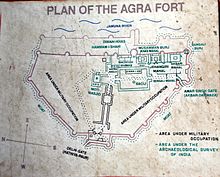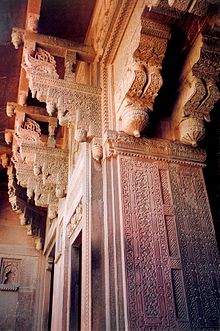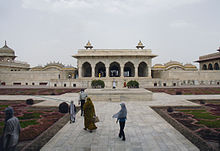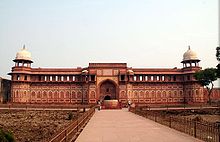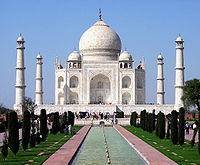- Agra Fort
-
Agra Fort * UNESCO World Heritage Site
Country India Type Cultural Criteria iii Reference 251 Region ** South Asia Inscription history Inscription 1983 (7th Session) * Name as inscribed on World Heritage List
** Region as classified by UNESCOAgra Fort, a beautiful fabulous enriching monument situated at Agra, Urdu: آگرہ قلعہ) is a UNESCO World Heritage site located in Agra, Uttar Pradesh, India. It is about 2.5 km northwest of its more famous sister monument, the Taj Mahal. The fort can be more accurately described as a walled city. After Panipat, Mughals captured the fort and a vast treasure - which included a diamond that was later named as the Koh-i-Noor diamond - was seized. Babur stayed in the fort in the palace of Ibrahim. He built a baoli (step well) in it. Humayun was crowned here in 1530. Humayun was defeated in Bilgram in 1540. Sher Shah held the fort for five years. The Mughals defeated the Afghans finally at Panipat in 1556.
Realizing the importance of its central situation, Akbar made it his capital and arrived in Agra in 1558. His historian, Abdul Fazal, recorded that this was a brick fort known as 'Badalgarh' . It was in a ruined condition and Akbar had it rebuilt with red sandstone from Barauli area in Rajasthan. Architects laid the foundation and it was built with bricks in the inner core with sandstone on external surfaces. Builders worked on it for eight years, completing it in 1573.
It was only during the reign of Akbar's grandson, Shah Jahan, that the site took on its current state. The legend is that Shah Jahan built the beautiful Taj Mahal for his wife, Mumtaz Mahal. Unlike his grandfather, Shah Jahan tended to have buildings made from white marble, often inlaid with gold or semi-precious gems. He destroyed some of the earlier buildings inside the fort in order to make his own.
At the end of his life, Shah Jahan was imprisoned by his son, Aurangzeb, in the fort. It is rumored that Shah Jahan died in Musamman Burj, a tower with a marble balcony with a view of the Taj Mahal.
The fort was the site of a battle during the Indian rebellion of 1857, which caused the end of the British East India Company's rule in India, and led to a century of direct rule of India by Britain.
Contents
History
It was originally a brick fort, held by the Hindu Sikarwar Rajputs. It was mentioned for the first time in 1080 AD when a Ghaznavide force captured it. Sikandar Lodi (1488–1517) was the first Sultan of Delhi who shifted to Agra and lived in the fort. He governed the country from here and Agra assumed the importance of the second capital. He died in the fort in 1517 and his son, Ibrahim Lodi, held it for nine years until he was defeated and killed at Panipat in 1526. Several palaces, wells and a mosque were built by him in the fort during his period.
After Panipat, Mughals captured the fort and a vast treasure - which included a diamond that was later named as the Koh-i-Noor diamond - was seized. Babur stayed in the fort in the palace of Ibrahim. He built a baoli (step well) in it. Humayun was crowned here in 1530. Humayun was defeated in Bilgram in 1540. Sher Shah held the fort for five years. The Mughals defeated the Afghans finally at Panipat in 1556.
Realizing the importance of its central situation, Akbar made it his capital and arrived in Agra in 1558. His historian, Abdul Fazal, recorded that this was a brick fort known as 'Badalgarh' . It was in a ruined condition and Akbar had it rebuilt with red sandstone from Barauli area in Rajasthan. Architects laid the foundation and it was built with bricks in the inner core with sandstone on external surfaces. Some 1,444,000 builders worked on it for eight years, completing it in 1573.
It was only during the reign of Akbar's grandson, Shah Jahan, that the site took on its current state. The legend is that Shah Jahan built the beautiful Taj Mahal for his wife, Mumtaz Mahal. Unlike his grandfather, Shah Jahan tended to have buildings made from white marble, often inlaid with gold or semi-precious gems. He destroyed some of the earlier buildings inside the fort in order to make his own.
At the end of his life, Shah Jahan was imprisoned by his son, Aurangzeb, in the fort. It is rumored that Shah Jahan died in Muasamman Burj, a tower with a marble balcony with a view of the Taj Mahal.
The fort was the site of a battle during the Indian rebellion of 1857, which caused the end of the British East India Company's rule in India, and led to a century of direct rule of India by Britain.
Layout
 Inside the Musamman Burj, where Shah Jahan spent the last seven years of his life under house arrest by his son Aurangzeb.
Inside the Musamman Burj, where Shah Jahan spent the last seven years of his life under house arrest by his son Aurangzeb.
The 94-acre (380,000 m2) fort has a semicircular plan, its chord lies parallel to the river and its walls are seventy feet high. Double ramparts have massive circular bastions at intervals, with battlements, embrasures, machicolations and string courses. Four gates were provided on its four sides, one Khizri gate opening on to the river.
Two of the fort's gates are notable: the "Delhi Gate" and the "Lahore Gate." The Lahore Gate is also popularly also known as the Amar Singh Gate, for Amar Singh Rathore.
The monumental Delhi Gate, which faces the city on the western side of the fort, is considered the grandest of the four gates and a masterpiece of Akbar's time. It was built circa 1568 both to enhance security and as the king's formal gate, and includes features related to both. It is embellished with inlay work in white marble, proof to the richness and power of the Great Mughals. A wooden drawbridge was used to cross the moat and reach the gate from the mainland; inside, an inner gateway called Hathi Pol ("Elephant Gate") - guarded by two life-sized stone elephants with their riders - added another layer of security. The drawbridge, slight ascent, and 90-degree turn between the outer and inner gates make the entrance impregnable. During a siege, attackers would employ elephants to crush a fort's gates. Without a level, straight run-up to gather speed, however, something prevented by this layout, elephants are ineffective.
Because the Indian military (the Parachute Brigade in particular) is still using the northern portion of the Agra Fort, the Delhi Gate cannot be used by the public. Tourists enter via the Amar Singh Gate.
The site is very important in terms of architectural history. Abul Fazal recorded that five hundred buildings in the beautiful designs of Bengal and Gujarat were built in the fort. Some of them were demolished by Shahjahan to make way for his white marble palaces. Most of the others were destroyed by the British between 1803 and 1862 for raising barracks. Hardly thirty Mughal buildings have survived on the south-eastern side, facing the river. Of these, the Delhi Gate and Akbar Gate and one palace - "Bengali Mahal" - are representative Akbari buildings.
Akbar Darwazza (Akbar Gate) was renamed Amar Singh Gate by the British. The gate is similar in design to the Delhi Gate. Both are built of red sandstone.
The Bengali Mahal is built of red sandstone and is now split into Akbari Mahal and Jahangiri mahal.
Some of the most historically interesting mixing of Hindu and Islamic architecture are found here. In fact, some of the Islamic decorations feature haraam (forbidden) images of living creatures - dragons, elephants and birds, instead of the usual patterns and calligraphy seen in Islamic surface decoration.
Sites and structures
- Anguri Bagh (Grape Garden)- 85 square, geometrically arranged gardens[1]
- Diwan-i-Am (Hall of Public Audience) - was used to speak to the people and listen to petitioners and once housed the Peacock Throne
- Diwan-i-Khas (Hall of Private Audience) - was used to receive kings and dignitary, features black throne of Jehangir
- Golden Pavilions - beautiful pavilions with roofs shaped like the roofs of Bengali huts
- Jahangiri Mahal - built by Akbar for his son Jehangir
- Khas Mahal - white marble palace, one of the best examples of painting on marble
- Macchi Bhawan (Fish Enclosure) - grand enclosure for harem functions, once had pools and fountains
- Mina Masjid (Heavenly Mosque) - private mosque used by mujahara
- Moti Masjid (Pearl Mosque) - mosque built for use by members of royal court
- Musamman Burj - a large, octagonal tower with a balcony facing the Taj Mahal
- Takht-i-Jahangir - Throne of Jahangir
- Nagina Masjid (Gem Mosque) - mosque designed for the ladies of the court
- Naubat Khana (Drum House) - a place where the king's musicians played
- Rang Mahal - where the king's wives and mistresses lived
- Shahi Burj - Shah Jahan's private work area
- Shah Jahani Mahal - Shah Jahan's first attempt at modification of the red sandstone palace
- Sheesh Mahal or Shish Mahal (Mirror Palace) - royal dressing room featuring tiny mirror-like glass-mosaic decorations, and drums built into the walls.
- Zenana Mina Bazaar (Ladies Bazaar) - right next to the balcony, where only female merchants sold wares
Popular culture
- The Agra Fort won the Aga Khan Award for Architecture in 2004. India Post issued a stamp to commemorate this event
- The Agra Fort plays a key role in the Sherlock Holmes mystery The Sign of the Four, by Sir Arthur Conan Doyle.
- The Agra Fort was featured in the music video for Habibi Da, a hit song of Egyptian pop star Hisham Abbas.
- Shivaji came to Agra in 1666 as per the "Purandar Treaty" entered into with Mirza Raje Jaisingh to met Aurangzeb in the Diwan-i-Khas. In the audience he was deliberately placed behind men of lower rank, Insulted he stormed out of the imperial audience and was confined to Jai Sing's quarters on 12 May 1666. Fearing the dungeons and execution, in a famously sweet legend, he escaped on 17 August 1666. A heroic equestrian statue of Shivaji has been erected outside the fort.
- In the second expansion pack for the videogame Age of Empires 3, the Asian Dynasties, Agra fort is one of five wonders for the Indian civilization.
Gallery
See also
Notes
- ^ "Agra Photo Album". Pratheep.com. http://www.pratheep.com/agra.shtml. Retrieved 2010-12-22.
Sources
External links
- Agra Fort in UNESCO List
- ASI website
- World Heritage Online Tour - 360 degree panoramas of fort buildings
- Historical images of Europeana.eu
- Diwan-e-am panorama pictures
- Centre to secure world heritage status for Red Fort - Milli Gazette article dated 16–31 May 2004
- Pictures of Agra Fort Pictures of Agra Fort from a backpackers trip around India
- Painting of the Delhi Gate
Categories:- Agra
- Mughal architecture
- Mughal Empire
- Tourism in Uttar Pradesh
- Royal residences in India
- History of Uttar Pradesh
- Forts in Uttar Pradesh
- Forts in India
- Buildings and structures in Uttar Pradesh
- Buildings and structures in Agra
- Agra Fort
- Buildings and structures completed in 1573
- Visitor attractions in Agra
- World Heritage Sites in India
- Former Indian capital cities
- Archaeological monuments in Uttar Pradesh
Wikimedia Foundation. 2010.

